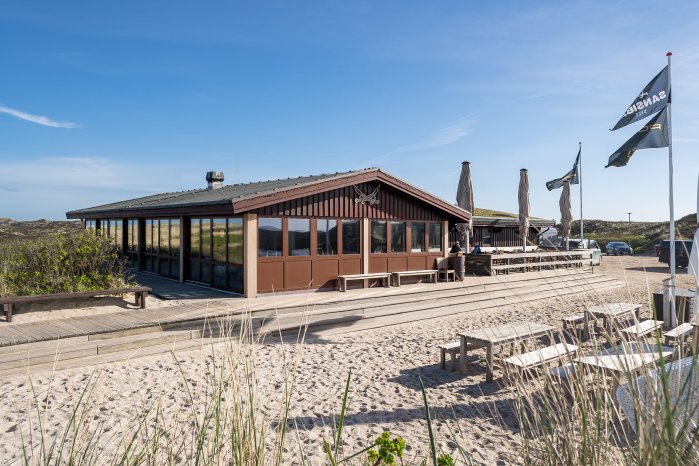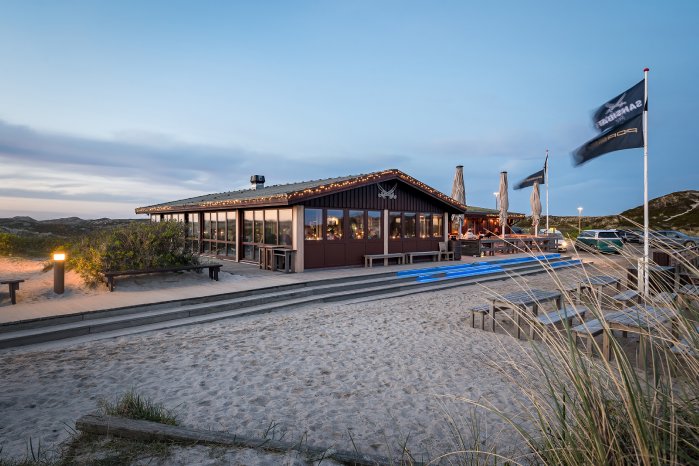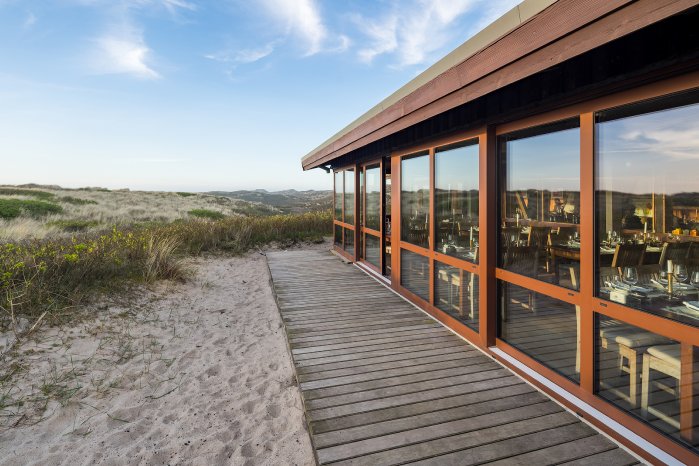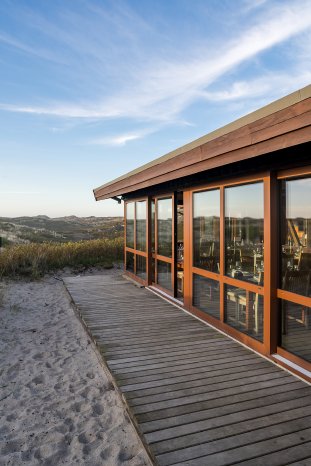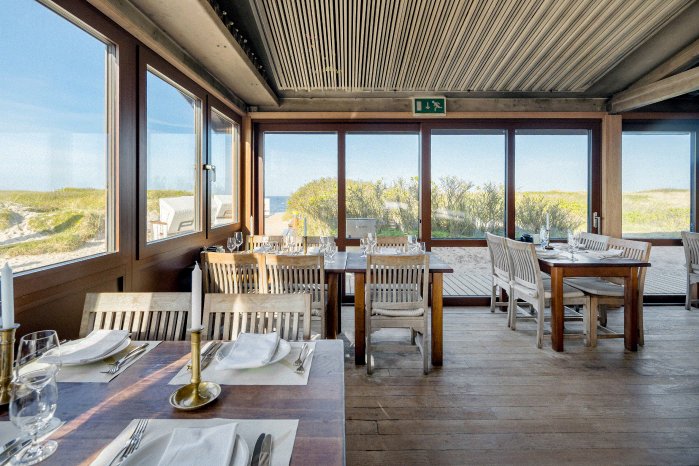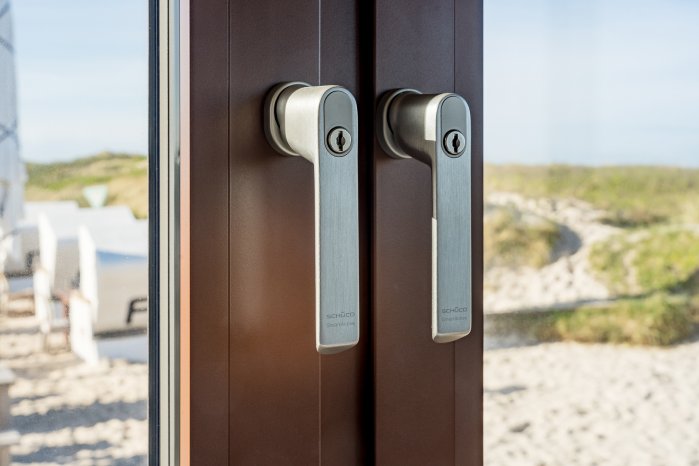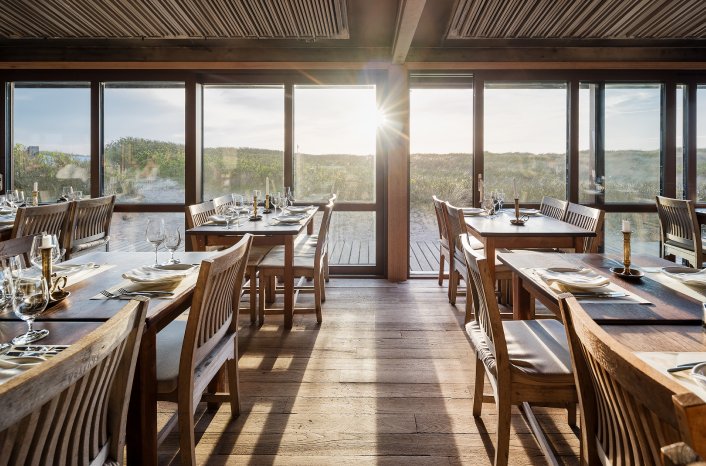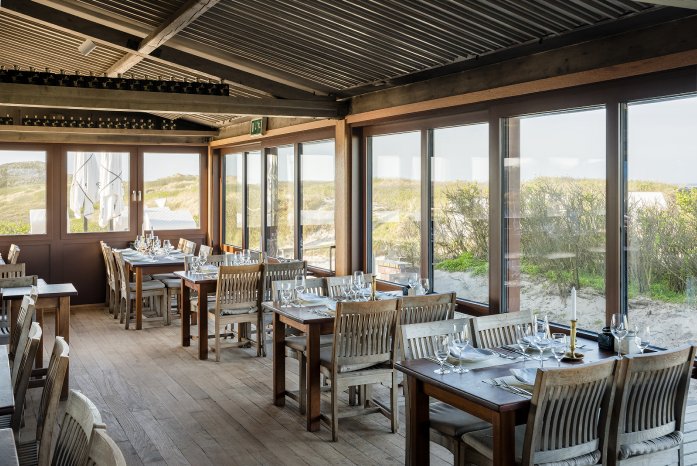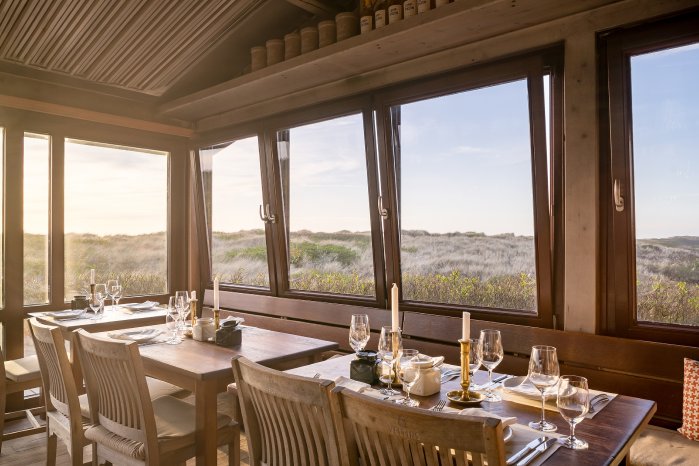Sansibar is known not just for its excellent food, but also for being a popular meeting place for VIP guests. Recently, a complete renovation of this bar on the beach was required. As part of the two-week construction works, the building was fitted with new sliding doors and windows, new kitchen flooring including screed, and a new ventilation system. Visually, barely any traces of the renovation can be seen, allowing the maritime charm and feel of Sansibar to remain largely unchanged.
“Originally, we wanted to just replace the windows,” reports owner Niklas Seckler, who is the second generation to run the restaurant together with his father. “However, gradually we came round to the idea of completely renovating the entire building rather than just the windows, in order to minimise its energy consumption for the long term and make Sansibar fit for the coming decades. It was very important to us that the building retained its particular charm and the end result was as close as possible to the original. This also concerned details such as the window colour, which my Grandfather chose back in his day.”
A variety of challenges
The renovation of Sansibar was a special experience for all involved. And this was not down to the size of the project, but rather predominantly because of the wide-ranging requirements that had to be taken into account. “These included everything from sufficient protection against the weather right through to compliance with building regulations for the protection of coastal areas and dunes,” comments Publicly Certified Expert Alexander Dupp, who was responsible for quality control on the building project and for adhering to all of the building regulations. “Added to this, of course, is the exposed location of Sansibar as a hotspot that is visited all year round, which is why the renovation had to be completed in the shortest period possible – to minimise the closure time. And last but not least, the special requirements of the building authority with regard to the size and colour of the units also had to be taken into account.”
In order to implement the diverse requirements of the renovation in the best way possible, those responsible for the project placed a great deal of emphasis on quality right from the start. This also concerned the choice of windows in particular. “At the very beginning, we were planning on installing wooden windows again,” explains Niklas Seckler. “Due to the close proximity to the water, the moist, salty air and the extreme weather conditions with very strong winds and sandstorms, we decided – after close consultation with Alexander Dupp – to install long-lasting and extremely weather-resistant aluminium windows. Because that would mean we would never have to worry about renovating them again for the rest of our lives.”
A focus on quality
Architect Albert Seckler, Niklas Seckler's uncle, was ultimately commissioned with planning the building work. The work was carried out by window fabricator Gauermann from Aalen in accordance with the recommendations of expert Alexander Dupp. After an initial on-site meeting with Managing Director Gerd Gauermann, it quickly became clear that Sansibar's new opening units should be constructed using Schüco profiles.
Based on the many different requirements, the Schüco AWS 75 SI+ window system was selected in combination with the Schüco ASE 80.HI lift-and-slide system. The configuration features a slimline look, easy access and a high level of comfort. The Schüco AWS 75 SI+ (Super Insulation) window system with its narrow profiles enables optimised thermal insulation, while the highly thermally insulated Schüco ASE 80.HI (High Insulation) sliding and lift-and-slide system integrates a level threshold, so that there are flowing, barrier-free transitions between the inside and outside areas. Guests and staff alike benefit from this. Concealed fittings components emphasise the minimalist and high-quality design, even when open.
Preliminary structural calculation
As part of the planning of the works, Schüco initially performed a preliminary structural calculation of the large-scale window units. “For the precise design, we then consulted Alexander Dupp's detailed expert report, which took into account both the structural scenario and the specific weather conditions of the site,” reports Gerd Gauermann, who has worked with Schüco for years and who values not only the high product quality, but also the outstanding project support, from planning right through to installation.
Based on the local positive and negative wind loads and the parameters of seawater, rain and sand, the design achieves high resistance to wind load corresponding to class B5/C5, a high level of air permeability corresponding to class 3 and watertightness corresponding to E900/E1050.
Due to the particular local conditions, high corrosion protection was also necessary. “We therefore made the mutual decision to apply an extremely weather and seawater-resistant surface finish made from Duraflon to all of the profiles before delivery to the building site,” explains Gerd Gauermann. “In parallel to this, the original look of the units also had to be taken into account. We worked out the exact colour in advance in cooperation with the building authorities by means of colour samples, in order to retain almost the exact same timber colour shade as the existing units.”
The high quality standard was further increased with the Schüco ULC label (Ultra Low Carbon aluminium), which stipulates a content of at least 75% recycled aluminium in the production of the profiles.
The topic of decarbonisation is becoming increasingly important for Schüco and as such was a focus at the 2023 BAU exhibition in Munich. The background to this is the new “Fit for 55” set of policy proposals as part of the European Green Deal, which the European Commission introduced with the aim of reducing greenhouse gas emissions in the EU by 55% by 2030 compared to 1990 and achieving climate neutrality by 2050. “The new Ultra Low Carbon aluminium label is an intelligent response to this strict regulation,” explains Gerd Gauermann. “It ensures that, through the use of recycled aluminium, fewer fossil fuels are consumed during production and, instead, as much renewable energy is used as possible, in order to considerably reduce the carbon footprint.”
For his own business, Gerd Gauermann also sees huge advantages in the new label. “The increasing requirements in terms of sustainability will also mean greater demands are placed on us,” he says, looking to the future. “Anyone who is unable to establish themselves in this area will quickly disappear from the market in the coming years. We need to continually reduce the resources involved in the construction and operation of buildings – across the entire supply chain of fabrication, assembly and delivery. With Schüco, we have a strong partner by our side.”
The IoF ID tag
Another element improving the operation of the building is the Schüco IoF ID tag (IoF = Internet of Façades), which is installed in the profile rebate and makes all of the information about the fabricated profile digitally available at a glance via a QR code. The system can provide information at any time about the systems and profile technology installed, as well as details of guarantees or the maintenance history. This creates an efficient basis for a digital service history throughout the entire lifecycle and extends the service life of the units. “As a result, the component in question can be identified and located quickly and easily at any time, and automatically linked to all of the information and documentation belonging to the product,” explains Gerd Gauermann.
Re-opening after two weeks
Further challenges arose on site. “As already mentioned, for all of the renovation work, we only had a short time window available of two weeks,” recalls Gerd Gauermann. Despite these difficult conditions, the project was still completed on time. “Due to the high quality of the product and the long pre-planning phase of all those involved in the project, everything worked out really well with the renovation and it was also possible to keep to the tight schedule,” says a delighted Alexander Dupp. Sansibar is therefore perfectly equipped for the coming decades.
Project details
Project: Renovation of Sansibar, Sylt
Architectural practice: Albert Seckler
Client: Sansibar, Niklas Seckler
Schüco fabricator: Fensterbau Gauermann GmbH, Aalen
Schüco materials / products installed:
Lift-and-slide system: Schüco ASE 80.HI (Aluminium Sliding Element)
Window system: Schüco AWS 75.SI+ (Aluminium Window System)
Smart Building: Schüco IoF ID (Internet of Façades)
Completion date: February 2024
